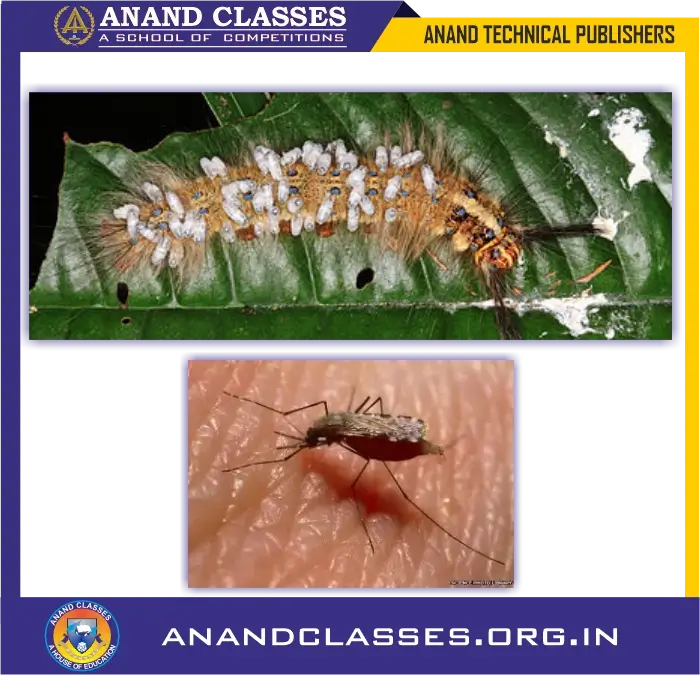ANAND CLASSES Study material and Notes to explore Parasitic Nutrition essential for Class 10 Science and NEET Foundation studies which includes MCQS, Questions Answers, Worksheet, Test Paper.
Parasitic Nutrition
Parasitic nutrition is a mode of heterotrophic nutrition in which an organism (called a parasite) derives its food from another living organism (called a host) without killing it. The parasite benefits from this relationship, whereas the host may suffer harm. Parasites depend entirely or partially on their hosts for food and other necessities. This type of nutrition is commonly observed in various fungi, bacteria, plants, and animals.

Characteristics of Parasitic Nutrition
- Dependency on a Host: Parasites cannot produce their own food and rely on their host for nourishment.
- No Benefit to Host: The host does not receive any benefits from the parasite and often suffers harm.
- Harm to Host: The parasite usually weakens the host by extracting essential nutrients.
- Common in Various Organisms: Parasitic nutrition is observed in fungi, bacteria, plants, and animals.
- Specific Adaptations: Many parasites have specialized structures such as suckers, hooks, or adhesive organs to attach to the host and extract nutrients.
Types of Parasites
Parasites can be categorized based on various factors, such as their dependence on the host, the type of host they infect, and their location.
1. Based on Dependency
- Obligate Parasites: These parasites completely depend on the host for their survival and cannot live without it. Example: Plasmodium.
- Facultative Parasites: These organisms can survive independently but become parasitic under specific conditions. Example: Certain fungi.
2. Based on Location
- Ectoparasites: These parasites live on the external surface of the host’s body. Example: Lice, ticks, and leeches.
- Endoparasites: These parasites live inside the host’s body, often within organs or tissues. Example: Tapeworms and roundworms.
Examples of Parasites
- Plant Parasites: Cuscuta (Amarbel), Rafflesia.
- Animal Parasites: Plasmodium (causes malaria), tapeworms, roundworms, lice, leeches, and ticks.
- Microbial Parasites: Certain fungi and bacteria that cause diseases in plants, animals, and humans.
Conceptual Questions with Answers
Q1. What is parasitic nutrition?
A1. Parasitic nutrition is a type of heterotrophic nutrition in which an organism (parasite) derives its food from another living organism (host) without providing any benefits in return. The host is often harmed by this relationship.
Q2. Name two plant parasites and two animal parasites.
A2.
- Plant parasites: Cuscuta (Amarbel), Rafflesia.
- Animal parasites: Plasmodium, tapeworm.
Q3. How does a parasite affect its host?
A3. A parasite weakens its host by extracting essential nutrients, leading to malnutrition, diseases, stunted growth, and, in extreme cases, death.
Q4. Differentiate between parasitic and saprophytic nutrition.
A4.
| Parasitic Nutrition | Saprophytic Nutrition |
|---|---|
| The organism derives food from a living host. | The organism feeds on dead or decaying organic matter. |
| The host is harmed. | No host is required. |
| Example: Plasmodium, Cuscuta. | Example: Mushrooms, Rhizopus. |
Multiple-Choice Questions (MCQs)
1. Which of the following is an example of a plant parasite?
a) Mango tree
b) Cuscuta
c) Neem tree
d) Banyan tree
Answer: b) Cuscuta
2. Plasmodium, a parasite, causes which disease?
a) Typhoid
b) Malaria
c) Cholera
d) Tuberculosis
Answer: b) Malaria
3. Which of the following is NOT a parasite?
a) Roundworm
b) Tick
c) Grasshopper
d) Lice
Answer: c) Grasshopper
Do You Know?
- Parasitic plants like Cuscuta do not have chlorophyll and cannot perform photosynthesis.
- The malarial parasite, Plasmodium, completes its life cycle in two hosts: mosquitoes and humans.
- Leeches are used in medicinal therapy to remove impure blood from wounds.
- Roundworms can live inside the intestines of humans and cause malnutrition.
- Tapeworms can grow up to several meters long inside a host’s intestines.
Worksheet
Fill in the Blanks
- A parasite derives its food from a living _______ without killing it.
- _______ is a parasitic plant that lacks chlorophyll.
- _______ is an example of an animal parasite that causes malaria.
- The parasite usually _______ its host.
Answers: (1) host, (2) Cuscuta, (3) Plasmodium, (4) harms
Match the Following
| Column A | Column B |
|---|---|
| Plasmodium | Causes Malaria |
| Cuscuta | Plant Parasite |
| Tick | Animal Parasite |
| Leeches | Suck Blood |
Answers: 1-C, 2-B, 3-D, 4-A
Test Paper (Marks Distribution: 20 Marks)
Section A: Multiple-Choice Questions (1 mark each)
- Which of the following is NOT a parasite? (1 mark)
a) Cuscuta
b) Roundworm
c) Neem tree
d) Tick - Plasmodium causes: (1 mark)
a) Tuberculosis
b) Malaria
c) Influenza
d) Typhoid
Section B: Short Answer Questions (2 marks each)
3. Define parasitic nutrition with an example. (2 marks)
4. Why is Cuscuta called a parasite? (2 marks)
Section C: Long Answer Questions (4 marks each)
5. Explain the harmful effects of parasites on their hosts with examples. (4 marks)
6. Differentiate between parasitic and saprophytic nutrition with examples. (4 marks)
Important Points for Quick Revision
- A parasite derives its nutrition from a living host.
- The host is harmed, but the parasite benefits.
- Examples of parasites include Plasmodium, roundworms, lice, and tapeworms.
- Cuscuta is a plant parasite that lacks chlorophyll.
- Parasitic organisms can cause diseases in humans, animals, and plants.
- Ectoparasites live on the host’s body, while endoparasites live inside the host’s body.
🔷 Best Coaching Center for IIT-JEE, NEET, and Foundations
🔹 ANAND CLASSES – The best coaching institute for JEE, NEET, and Class 11-12 Foundations.
🔹 Buy complete study material at 👉 https://publishers.anandclasses.co.in/
🔹 Proprietor: NIRMAL ANAND Educations
🔹 Written by: Neeraj Anand
🔹 Published by: Anand Technical Publishers under Anand Classes
📞 Contact: +91-9463138669
📧 Email: anandclasses1996@gmail.com



